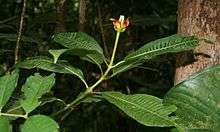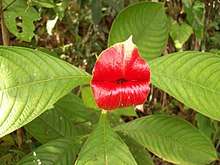Psychotria elata
Palicourea elata (formerly Psychotria elata.[1]), commonly known as hot lips,[2] and labios de puta,[3] is a tropical plant that ranges from Central to South American rain forests in countries such as Mexico, Costa Rica, Ecuador, Panama, and Colombia.[4] Palicourea elata is extremely sensitive and requires specific climates to grow, those climates most like rainforests are best suitable for this plant. It is most notable for its distinctly shaped red bracts and is consequently nicknamed “Hot Lips”. Though the bright red bracts are considered its most flashy feature, they are not the actual flowers of the plant but instead extravagant leaves; the flowers of Palicourea elata lie within the “red lip” leaves.[5] Just like human lips, the hot lips plant comes in a variety of shapes and forms offering a vast array of plants. P. elata is well-studied and has been documented over centuries to provide various health benefits to native communities. Due to these benefits and the overall appearance of the plant, it has been over-harvested and is now endangered.
| Psychotria elata | |
|---|---|
 | |
| Scientific classification | |
| Kingdom: | Plantae |
| Clade: | Tracheophytes |
| Clade: | Angiosperms |
| Clade: | Eudicots |
| Clade: | Asterids |
| Order: | Gentianales |
| Family: | Rubiaceae |
| Genus: | Palicourea |
| Species: | P. elata |
| Binomial name | |
| Palicourea elata (Sw.) Borhidi | |
| Synonyms | |
| |

Physical characteristics
.jpg)
P. elata can be described as a shrub that is part of the Rubiaceae family, also commonly known as the coffee, madder, or bedstraw family. The Rubiaceae family is recognizable for having simple, opposite leaves with interpetiolar stipules and can come in the form of terrestrial trees, herbs, lianas, or shrubs like P. elata. This plant will typically be found in the understory layer of rain forests. This species can grow from 1 to 3 meters, occasionally reaching 4 meters in height. The plant’s morphology can be quite variable as it is directly affected by the neighborhood structure of nearby plants, and overall light availability that the plant has access to. These variables, as well as the general resources available to the plant, have been shown to effect the biomechanics, allometry, and branching of P.elata, which, in turn, can effect height and leaf count.[6]
The most distinctive features of P. elata are its red bracts, a modified set of leaves. Before its flowers bloom, the bracts resemble a pair of human lips. The flowers of P. elata bloom from December to March and can be described as small, star-shaped flowers demonstrated in Figure 2[7]. P. elata is part of the Palicoura genus, and, as many plants of this genus, does not give off a scent. Due to the undetectable scent, the plant relies on its shape alone to attract pollinators, such as butterflies and hummingbirds[8]. Once pollinization and fertilization occurs, P. elata produces small black or dark blue berries[9]. These berries are then distributed via birds; a common mechanism that plants of the Palicoura genus use.
Properties

One of the main active phytochemicals in Palicourea Elota that have been found is Strictosidine. Using NMR spectrophotometry technique, it was found that this compound experienced many chemical shifts which often changed the chemical structure. Carvahlo Junior writes that these chemical shifts may function as precursors to different biosynthetic pathways that produce medically important compounds.[10] The plant has also been shown to have antimicrobial properties as well as anti-inflammatory properties.[11] Some species of Palicouria are known to contain psychedelic chemicals, the most common being dimethyltryptamine, or DMT.[5] This trait makes Palicouria popular to use in native communities for ceremonial and healing purposes.
Conservation Status
P. elata has become endangered due to deforestation in its native range. Expansive farming and legal and illegal harvesting of trees are causing primary growth and secondary growth forests to be turned into fields for crops, or pastures for livestock, and wastelands. It is to be noted that due to its kissable appearance, it has been widely used as a gift for Valentine’s Day and harvests can be overbearing[5]. Since this species is a understory shrub that relies on the shade that the overhanging trees provide, the population sizes are rapidly decreasing and harshly diminished by over-harvesting, climate changes, and loss of habitat[9]. The International Union for Conservation of Nature, or IUCN, has reported that one-tenth of all the Palicourea species are considered threatened. Even so, the endangered species status is not complete as it has been mostly accounted for species only in Ecuador, with many other Palicourea species existing outside the country[12]. If likewise threatened in the rest of its native range, P. elata and potentially a large portion its genus, are at risk.
Usage
The bark and leaves of P. elata are commonly used as folk medicine to cure earaches, cough, and skin irritation or rashes.[5] The Guna people native to Panama and Colombia have habitually used this flower to treat dyspnea.[9] In Nicaraguan communities, the plant has been used to help with the side effects from snake bites; all parts of the plant have been known to be used for this purpose. For medicinal uses, the desired parts of the plant are made into either a decoction for oral administration or as a poultice for topical administration.[13] As mentioned previously, the plant can offer a psychedelic effect that can potentially be used medically, but is mostly used in ceremonies in native communities.[5] Typically, the plant will be harvested in a secondary growth forest. There has been little research done and even less medical research done on Palicourea elata. Most of the data found on the plant is anecdotal evidence from native populations that has been tested to see if applicable in some way, such as with the antimicrobial and anti-inflammatory properties the plant contains. There is still much research to be done to determine the clinical uses of the plant.
See Also
References
- Borhidi, A. (September 2011). "Transfer of the Mexican species of Psychotria subgen. Heteropsychotria to Palicourea based on morphological and molecular evidences". Acta Botanica Hungarica. 53 (3–4): 241–250. doi:10.1556/ABot.53.2011.3-4.4.
- Huettmann, Falk (2015). "Conservation Research in the Cloud Forest of Central America with Lessons from Maderas Volcano, Ometepe, Nicaragua: A First-Person Narrative About Very Tough Fieldwork, Unfinished Data, and Climate Justice While Running Out of Time". Central American Biodiversity. pp. 419–433. doi:10.1007/978-1-4939-2208-6_17. ISBN 978-1-4939-2207-9.
- Hammel, B. (1996). Retrieved May 02, 2020, from http://www.mobot.org/MOBOT/plantmap/Hotlips.html
- World Checklist of Selected Plant Families (WCSP). (n.d.). Retrieved April 19, 2020, from https://wcsp.science.kew.org/namedetail.do?name_id=466529
- "The Psychotria Elata Plant is More Than Just a Resemblance of Kissable Lips. Here are 10 Reasons Why". Zane’s World.
- Guzmán Q, J. Antonio; Cordero, Roberto A. (2016). "Neighbourhood structure and light availability influence the variations in plant design of shrubs in two cloud forests of different successional status". Annals of Botany. 118 (1): 23–34. doi:10.1093/aob/mcw078. PMC 4934397. PMID 27245635.
- Wright, K. (2020, March 12). Psychotria Elata aka Hooker's Lips: Latin America's Kissable Flower. Retrieved May 02, 2020, from https://whenonearth.net/hookers-lips-central-south-americas-kissable-flower/
- Taylor, Charlotte M. (2008): Palicourea Aubl. (Rubiaceae: Psychotrieae). Version of 2008-APR-04.
- Sr., T. (2020, April 05). Hooker's Lips. Retrieved May 02, 2020, from https://www.ourbreathingplanet.com/hookers-lips/
- Carvalho Junior, Almir; Vieira, Ivo; Carvalho, Mario; Braz-Filho, Raimundo; S. Lima, Mary; Ferreira, Rafaela; José Maria, Edmilson; Oliveira, Daniela (11 January 2017). "13C-NMR Spectral Data of Alkaloids Isolated from Psychotria Species (Rubiaceae)". Molecules. 22 (1): 103. doi:10.3390/molecules22010103. PMC 6155581. PMID 28085077.
- Félix-Silva, Juliana; Silva-Junior, Arnóbio Antônio; Zucolotto, Silvana Maria; Fernandes-Pedrosa, Matheus de Freitas (2017). "Medicinal Plants for the Treatment of Local Tissue Damage Induced by Snake Venoms: An Overview from Traditional Use to Pharmacological Evidence". Evidence-Based Complementary and Alternative Medicine. 2017: 1–52. doi:10.1155/2017/5748256. PMID 28904556.
- International Union for Conservation of Nature (IUCN) (2008): [www.iucnredlist.org 2008 IUCN Red List of Threatened Species].
- Coe, Felix G.; Anderson, Gregory J. (January 2005). "Snakebite ethnopharmacopoeia of eastern Nicaragua". Journal of Ethnopharmacology. 96 (1–2): 303–323. doi:10.1016/j.jep.2004.09.026. PMID 15588683.